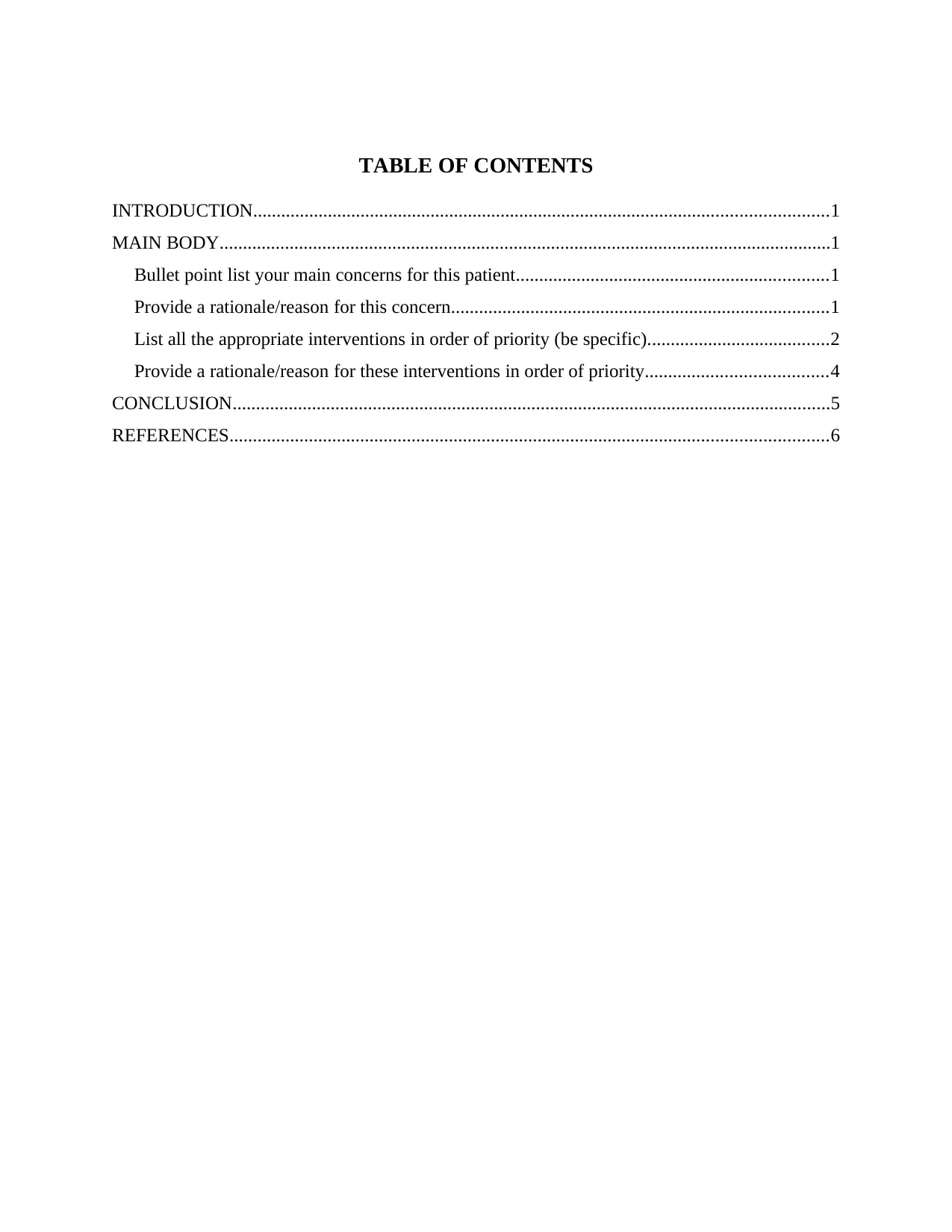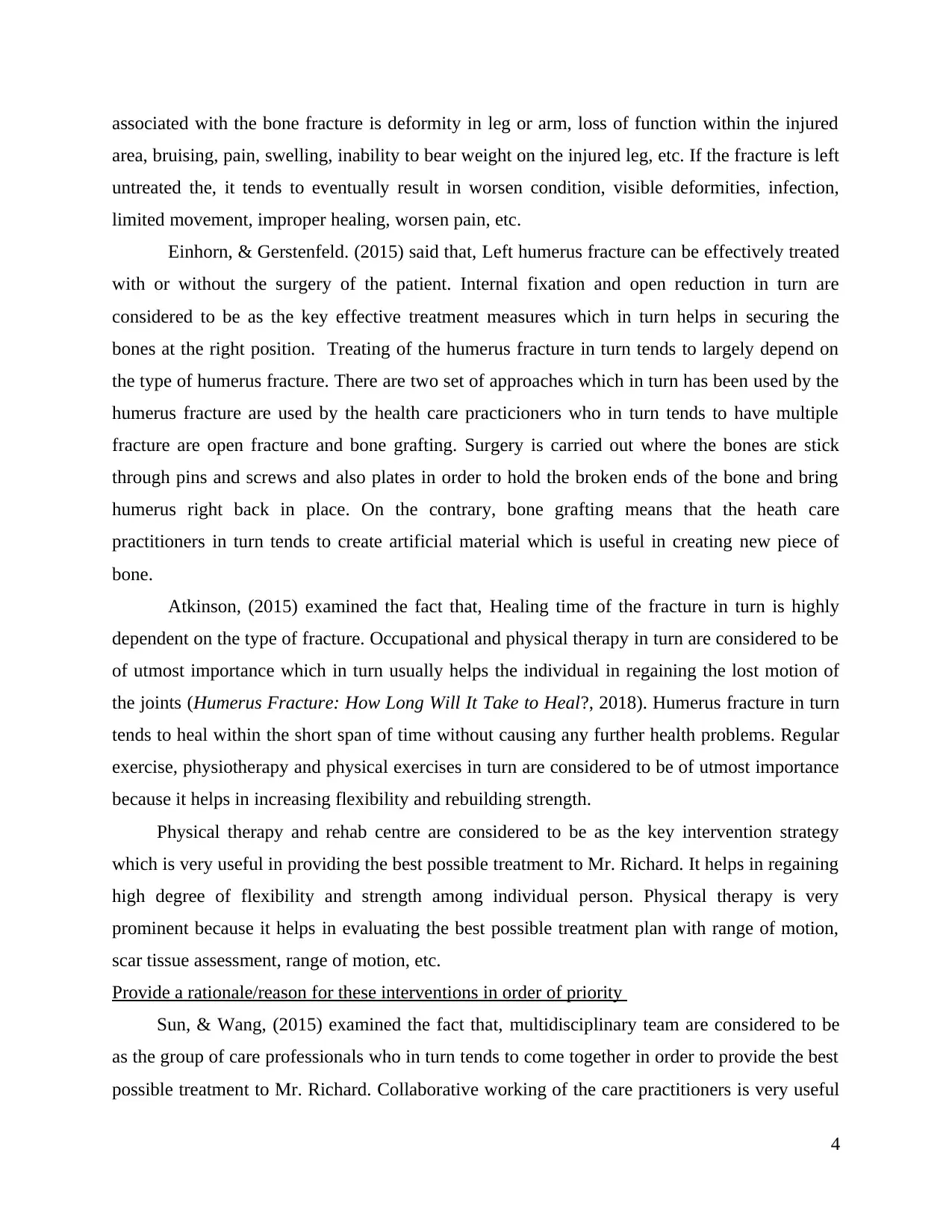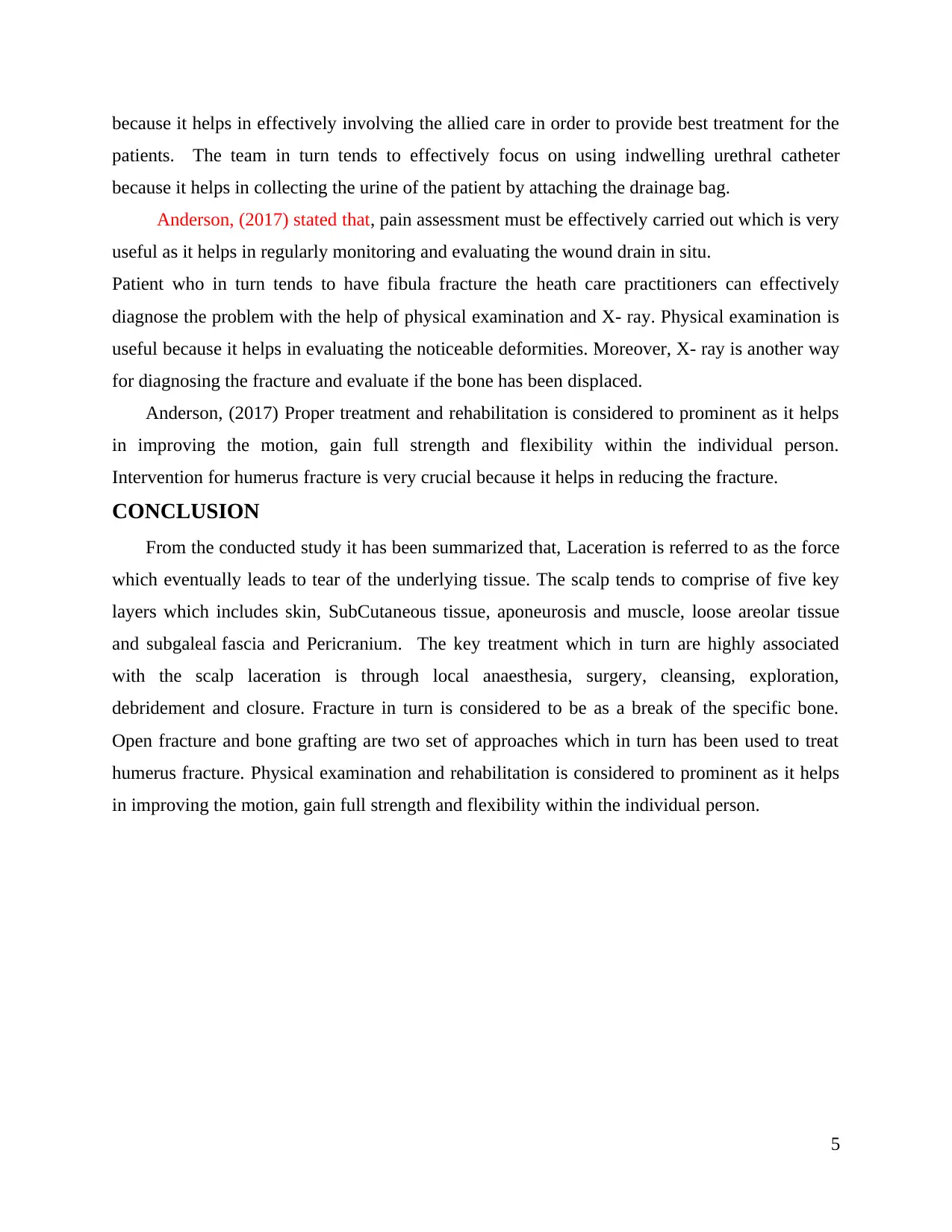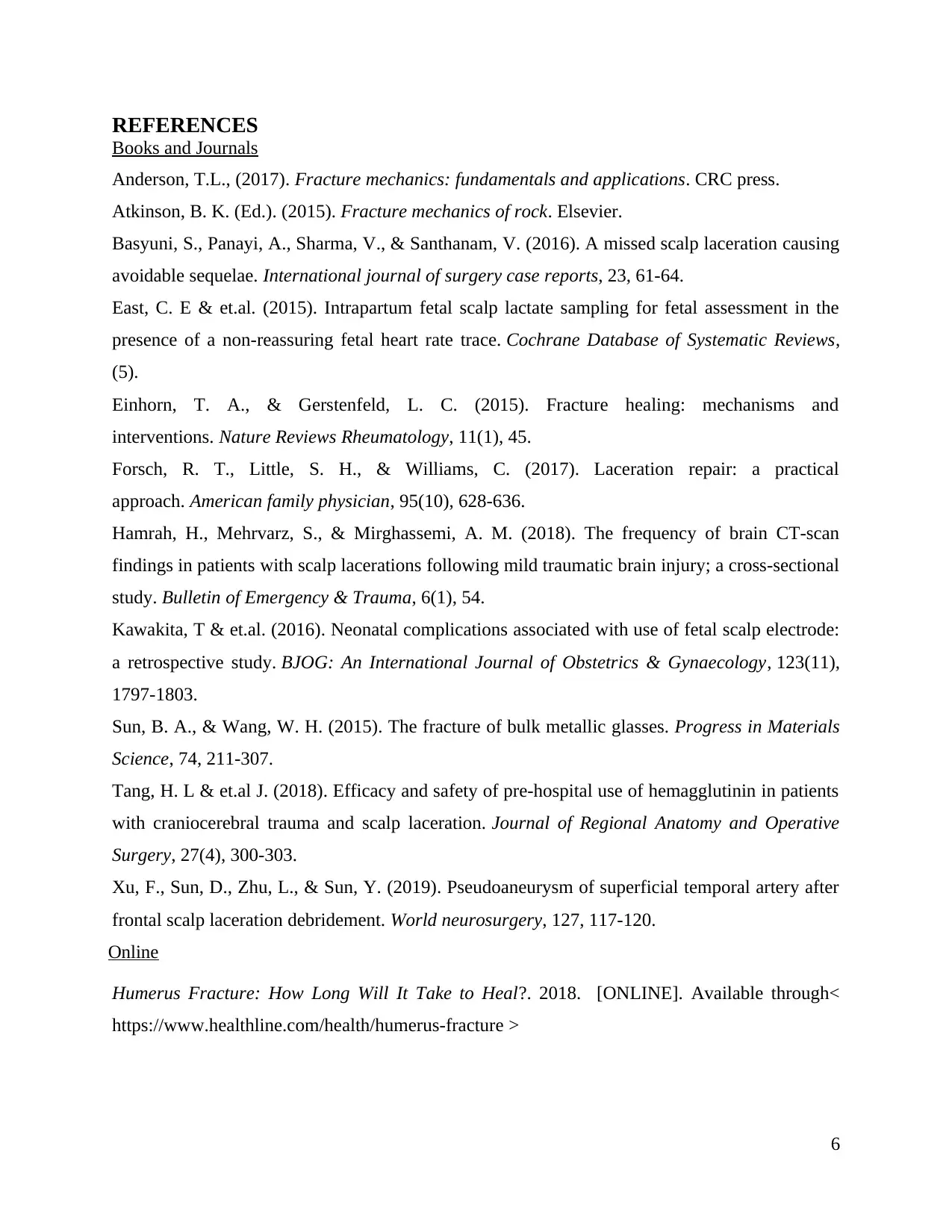Interventions for Scalp Laceration and Fractures - Case Study
VerifiedAdded on 2023/01/11
|8
|2709
|73
AI Summary
This case study focuses on the interventions for scalp laceration and fractures in a patient. It discusses the main concerns, rationale for the concerns, appropriate interventions, and their rationale. The study also highlights the pathophysiology of laceration and fractures.
Contribute Materials
Your contribution can guide someone’s learning journey. Share your
documents today.

Project
Secure Best Marks with AI Grader
Need help grading? Try our AI Grader for instant feedback on your assignments.

TABLE OF CONTENTS
INTRODUCTION...........................................................................................................................1
MAIN BODY...................................................................................................................................1
Bullet point list your main concerns for this patient...................................................................1
Provide a rationale/reason for this concern.................................................................................1
List all the appropriate interventions in order of priority (be specific).......................................2
Provide a rationale/reason for these interventions in order of priority.......................................4
CONCLUSION................................................................................................................................5
REFERENCES................................................................................................................................6
INTRODUCTION...........................................................................................................................1
MAIN BODY...................................................................................................................................1
Bullet point list your main concerns for this patient...................................................................1
Provide a rationale/reason for this concern.................................................................................1
List all the appropriate interventions in order of priority (be specific).......................................2
Provide a rationale/reason for these interventions in order of priority.......................................4
CONCLUSION................................................................................................................................5
REFERENCES................................................................................................................................6

INTRODUCTION
In this specific case scenario, Mr. Richards is a 43year-old man who was admitted to
surgical ward where you are currently on placement. Moreover, a motor vehicle accident results
in laceration to his left forehead and multiple fractures. Mr. Richards has just returned from a
surgical procedure in order to repair his fractured left humerus and tibia and fibula. Moreover,
the current observations are blood pressure 100/75, heart rate 98, respiratory rate 22,
Temperature 36.7, blood oxygen level (SpO2) 98% on Room air. Subsequently, Mr. Richards
has been currently feeling drowsy, has an intravenous therapy, indwelling urethral catheter and
wound drain in situ in patient’s left leg. This study will focus on highlighting on providing key
rationale associated with the study. Moreover, this study also tends to evaluate the appropriate
intervention strategy for the patient. Effectively understanding the key layers associated with the
layers of scalp and also blood supply in order to successfully stop high degree of bleeding
because of laceration.
MAIN BODY
Bullet point list your main concerns for this patient
The key concern associated with the patient are:
A motor vehicle accident results in laceration to his left forehead and multiple fractures.
Surgical procedure in order to repair his fractured left humerus and tibia and fibula.
The current observations are blood pressure 100/75, heart rate 98, respiratory rate 22,
Temperature 36.7, blood oxygen level (SpO2) 98% on Room air.
Mr. Richards is feeling drowsy, has an intravenous therapy, indwelling urethral catheter
and wound drain in situ in patient’s left leg.
Wound drain should be significantly removed in situ. However, the longer the drain tends
to remain in situ it tends to highly increase the risk of infection. This eventually results in
the increased amount of pain and trauma.
Provide a rationale/reason for this concern
Motor vehicle accident is an effective measure because it helps in critically examining the
cause of drowsiness and fracture within the patient. This study is useful because it helps the
nursing care practitioners in critically examining and evaluating the reason for such medical
conditions which in turn largely influence the medical condition of the Mr. Richards. The key
reason for this concern is that it helps the nursing practitioners evaluate the effective nursing plan
1
In this specific case scenario, Mr. Richards is a 43year-old man who was admitted to
surgical ward where you are currently on placement. Moreover, a motor vehicle accident results
in laceration to his left forehead and multiple fractures. Mr. Richards has just returned from a
surgical procedure in order to repair his fractured left humerus and tibia and fibula. Moreover,
the current observations are blood pressure 100/75, heart rate 98, respiratory rate 22,
Temperature 36.7, blood oxygen level (SpO2) 98% on Room air. Subsequently, Mr. Richards
has been currently feeling drowsy, has an intravenous therapy, indwelling urethral catheter and
wound drain in situ in patient’s left leg. This study will focus on highlighting on providing key
rationale associated with the study. Moreover, this study also tends to evaluate the appropriate
intervention strategy for the patient. Effectively understanding the key layers associated with the
layers of scalp and also blood supply in order to successfully stop high degree of bleeding
because of laceration.
MAIN BODY
Bullet point list your main concerns for this patient
The key concern associated with the patient are:
A motor vehicle accident results in laceration to his left forehead and multiple fractures.
Surgical procedure in order to repair his fractured left humerus and tibia and fibula.
The current observations are blood pressure 100/75, heart rate 98, respiratory rate 22,
Temperature 36.7, blood oxygen level (SpO2) 98% on Room air.
Mr. Richards is feeling drowsy, has an intravenous therapy, indwelling urethral catheter
and wound drain in situ in patient’s left leg.
Wound drain should be significantly removed in situ. However, the longer the drain tends
to remain in situ it tends to highly increase the risk of infection. This eventually results in
the increased amount of pain and trauma.
Provide a rationale/reason for this concern
Motor vehicle accident is an effective measure because it helps in critically examining the
cause of drowsiness and fracture within the patient. This study is useful because it helps the
nursing care practitioners in critically examining and evaluating the reason for such medical
conditions which in turn largely influence the medical condition of the Mr. Richards. The key
reason for this concern is that it helps the nursing practitioners evaluate the effective nursing plan
1

for the Mr. Richards. It is very useful because it helps the nursing practitioner in evaluating how
severe the laceration on left forehead (Basyuni, Panayi, Sharma & Santhanam, (2016)).
Laceration is referred to as the pattern of injury where the blunt force in turn eventually results in
underlying tissues and tearing up of the skin. This helps the nursing practitioners in providing the
best possible intervention to such medical problem. The key reason associated with the motor
vehicle accident is to effectively evaluate the cause of multiple fractures within Mr. Richard.
This study is considered to be very prominent because it helps in critically evaluating the various
key factors which are very prominent to effectively evaluate the severe fractures within the
patient.
Pathophysiology
Hamrah, Mehrvarz & Mirghassemi, (2018) examined the fact that, Laceration in turn is
usually caused by the injury from force or blunt objects. Laceration is referred to as the force
which eventually leads to tear of the underlying tissue and tear of the skin within the person. The
scalp tends to comprise of five key layers which includes skin, SubCutaneous tissue, aponeurosis
and muscle, loose areolar tissue and subgaleal fascia and Pericranium. Within lacedration, the
sepration tends to mainly occur at loose areolar tissue layer. Moreover, the musculoaponeurotic
layer tends to comprise of superficial temporal artery because the muscle tends to require
copious blood supply in order to function properly.
Pathophysiology
Humerus fracture
They in turn are usually caused by the direct trauma to the arm which in turn eventually
result in displacement of the bone and results in humerus fracture Humerus Fracture: How Long
Will It Take to Heal?, 2018).
Tibial and fibula fracture
According to Xu, Sun, Zhu, & Sun, (2019) examined the fact that, Tibial fracture is caused
because of the motor vehicle accident. On the other hand, fibula fracture is mainly linked with
describing the break of the fibula bone. However, fibula and tabia are considered to be as the two
long bones within the lower leg. The fibula is considered to be as the small bone which has been
located on outside of the leg (Basyuni, Panayi, Sharma & Santhanam, (2016)). Moreover, the
tabia is referred to as the weight bearing bone inside the lower leg. Symptoms associated with
the fibula fracture are bleeding, numbness, tender to touch, visible deformity, bleeding, etc.
2
severe the laceration on left forehead (Basyuni, Panayi, Sharma & Santhanam, (2016)).
Laceration is referred to as the pattern of injury where the blunt force in turn eventually results in
underlying tissues and tearing up of the skin. This helps the nursing practitioners in providing the
best possible intervention to such medical problem. The key reason associated with the motor
vehicle accident is to effectively evaluate the cause of multiple fractures within Mr. Richard.
This study is considered to be very prominent because it helps in critically evaluating the various
key factors which are very prominent to effectively evaluate the severe fractures within the
patient.
Pathophysiology
Hamrah, Mehrvarz & Mirghassemi, (2018) examined the fact that, Laceration in turn is
usually caused by the injury from force or blunt objects. Laceration is referred to as the force
which eventually leads to tear of the underlying tissue and tear of the skin within the person. The
scalp tends to comprise of five key layers which includes skin, SubCutaneous tissue, aponeurosis
and muscle, loose areolar tissue and subgaleal fascia and Pericranium. Within lacedration, the
sepration tends to mainly occur at loose areolar tissue layer. Moreover, the musculoaponeurotic
layer tends to comprise of superficial temporal artery because the muscle tends to require
copious blood supply in order to function properly.
Pathophysiology
Humerus fracture
They in turn are usually caused by the direct trauma to the arm which in turn eventually
result in displacement of the bone and results in humerus fracture Humerus Fracture: How Long
Will It Take to Heal?, 2018).
Tibial and fibula fracture
According to Xu, Sun, Zhu, & Sun, (2019) examined the fact that, Tibial fracture is caused
because of the motor vehicle accident. On the other hand, fibula fracture is mainly linked with
describing the break of the fibula bone. However, fibula and tabia are considered to be as the two
long bones within the lower leg. The fibula is considered to be as the small bone which has been
located on outside of the leg (Basyuni, Panayi, Sharma & Santhanam, (2016)). Moreover, the
tabia is referred to as the weight bearing bone inside the lower leg. Symptoms associated with
the fibula fracture are bleeding, numbness, tender to touch, visible deformity, bleeding, etc.
2
Secure Best Marks with AI Grader
Need help grading? Try our AI Grader for instant feedback on your assignments.

List all the appropriate interventions in order of priority (be specific).
East & et.al. (2015) examined the fact that, the key intervention to treat scalp laceration
within the patient it is considered to be a severe injury within the patient which has been caused
because of heavy force or blunt object. The key treatment which in turn are highly associated
with the scalp laceration is through local anaesthesia, surgery, cleansing, exploration,
debridement and closure. Injectable local anaesthesia is considered to be as one of the most
prominent measure which in turn helps in treating Mr. Richard for scalp laceration. Maximum
dose of lidocaine is 3 to 5 mg/kg and bupivacaine is 2.5 mg/kg. The first and foremost thing
which helps in treating the patient with scalp laceration is that, it tends to require removal of
any foreign bodies and attaining hemostasis. The bleeding within the patient can be effectively
stopped by applying high degree of pressure without or with the use of the local lidocaine.
Kawakita & et.al. (2016) stated that, controlling bleeding is considered to be of utmost
importance as lacerations leads to significant blood loss. Moreoverm a delayed closure of wound
within the patient in turn eventually leads high degree of risk of scarring and infection.
Intravenous therapy is considered to be as one of the most effective measure because it helps in
delivering fluid directly into the vein (Basyuni, Panayi, Sharma & Santhanam, (2016)). IV
therapy is prominent because it helps in using syringe at the high pressure.
Tang & et.al (2018) evaluated that, hair opposition, surgical staples and suturing are in
turn considered to be as the key treatment for attaining the best health care outcomes for the
scalp laceration. Staples are one of the most effective means which helps in treating scalp
laceration which in turn results in stating that the bleeding is under control. This method is
considered to be an effective method which helps in bringing bleeding under control.
Hair apposition technique is also one of the most prominent technique which in turn has been
highly provided in the cost effective way and it is also a less painful approach which eventually
results in scalp laceration repair. Another measure for treating scalp laceration is suturing (East
& et.al. (2015)). It is one of the most effective method which results in laceration repair. Sutures
is considered to be as a prominent technique over staples when there is large gap wound with
brisk bleeding.
Forsch, Little, & Williams, (2017) examined the fact that, Fracture in turn is considered
to be as a break of the specific bone. In this specific case scenario, factures has happened within
the individual because of motor vehicle accident. One of the key and prominent symptom
3
East & et.al. (2015) examined the fact that, the key intervention to treat scalp laceration
within the patient it is considered to be a severe injury within the patient which has been caused
because of heavy force or blunt object. The key treatment which in turn are highly associated
with the scalp laceration is through local anaesthesia, surgery, cleansing, exploration,
debridement and closure. Injectable local anaesthesia is considered to be as one of the most
prominent measure which in turn helps in treating Mr. Richard for scalp laceration. Maximum
dose of lidocaine is 3 to 5 mg/kg and bupivacaine is 2.5 mg/kg. The first and foremost thing
which helps in treating the patient with scalp laceration is that, it tends to require removal of
any foreign bodies and attaining hemostasis. The bleeding within the patient can be effectively
stopped by applying high degree of pressure without or with the use of the local lidocaine.
Kawakita & et.al. (2016) stated that, controlling bleeding is considered to be of utmost
importance as lacerations leads to significant blood loss. Moreoverm a delayed closure of wound
within the patient in turn eventually leads high degree of risk of scarring and infection.
Intravenous therapy is considered to be as one of the most effective measure because it helps in
delivering fluid directly into the vein (Basyuni, Panayi, Sharma & Santhanam, (2016)). IV
therapy is prominent because it helps in using syringe at the high pressure.
Tang & et.al (2018) evaluated that, hair opposition, surgical staples and suturing are in
turn considered to be as the key treatment for attaining the best health care outcomes for the
scalp laceration. Staples are one of the most effective means which helps in treating scalp
laceration which in turn results in stating that the bleeding is under control. This method is
considered to be an effective method which helps in bringing bleeding under control.
Hair apposition technique is also one of the most prominent technique which in turn has been
highly provided in the cost effective way and it is also a less painful approach which eventually
results in scalp laceration repair. Another measure for treating scalp laceration is suturing (East
& et.al. (2015)). It is one of the most effective method which results in laceration repair. Sutures
is considered to be as a prominent technique over staples when there is large gap wound with
brisk bleeding.
Forsch, Little, & Williams, (2017) examined the fact that, Fracture in turn is considered
to be as a break of the specific bone. In this specific case scenario, factures has happened within
the individual because of motor vehicle accident. One of the key and prominent symptom
3

associated with the bone fracture is deformity in leg or arm, loss of function within the injured
area, bruising, pain, swelling, inability to bear weight on the injured leg, etc. If the fracture is left
untreated the, it tends to eventually result in worsen condition, visible deformities, infection,
limited movement, improper healing, worsen pain, etc.
Einhorn, & Gerstenfeld. (2015) said that, Left humerus fracture can be effectively treated
with or without the surgery of the patient. Internal fixation and open reduction in turn are
considered to be as the key effective treatment measures which in turn helps in securing the
bones at the right position. Treating of the humerus fracture in turn tends to largely depend on
the type of humerus fracture. There are two set of approaches which in turn has been used by the
humerus fracture are used by the health care practicioners who in turn tends to have multiple
fracture are open fracture and bone grafting. Surgery is carried out where the bones are stick
through pins and screws and also plates in order to hold the broken ends of the bone and bring
humerus right back in place. On the contrary, bone grafting means that the heath care
practitioners in turn tends to create artificial material which is useful in creating new piece of
bone.
Atkinson, (2015) examined the fact that, Healing time of the fracture in turn is highly
dependent on the type of fracture. Occupational and physical therapy in turn are considered to be
of utmost importance which in turn usually helps the individual in regaining the lost motion of
the joints (Humerus Fracture: How Long Will It Take to Heal?, 2018). Humerus fracture in turn
tends to heal within the short span of time without causing any further health problems. Regular
exercise, physiotherapy and physical exercises in turn are considered to be of utmost importance
because it helps in increasing flexibility and rebuilding strength.
Physical therapy and rehab centre are considered to be as the key intervention strategy
which is very useful in providing the best possible treatment to Mr. Richard. It helps in regaining
high degree of flexibility and strength among individual person. Physical therapy is very
prominent because it helps in evaluating the best possible treatment plan with range of motion,
scar tissue assessment, range of motion, etc.
Provide a rationale/reason for these interventions in order of priority
Sun, & Wang, (2015) examined the fact that, multidisciplinary team are considered to be
as the group of care professionals who in turn tends to come together in order to provide the best
possible treatment to Mr. Richard. Collaborative working of the care practitioners is very useful
4
area, bruising, pain, swelling, inability to bear weight on the injured leg, etc. If the fracture is left
untreated the, it tends to eventually result in worsen condition, visible deformities, infection,
limited movement, improper healing, worsen pain, etc.
Einhorn, & Gerstenfeld. (2015) said that, Left humerus fracture can be effectively treated
with or without the surgery of the patient. Internal fixation and open reduction in turn are
considered to be as the key effective treatment measures which in turn helps in securing the
bones at the right position. Treating of the humerus fracture in turn tends to largely depend on
the type of humerus fracture. There are two set of approaches which in turn has been used by the
humerus fracture are used by the health care practicioners who in turn tends to have multiple
fracture are open fracture and bone grafting. Surgery is carried out where the bones are stick
through pins and screws and also plates in order to hold the broken ends of the bone and bring
humerus right back in place. On the contrary, bone grafting means that the heath care
practitioners in turn tends to create artificial material which is useful in creating new piece of
bone.
Atkinson, (2015) examined the fact that, Healing time of the fracture in turn is highly
dependent on the type of fracture. Occupational and physical therapy in turn are considered to be
of utmost importance which in turn usually helps the individual in regaining the lost motion of
the joints (Humerus Fracture: How Long Will It Take to Heal?, 2018). Humerus fracture in turn
tends to heal within the short span of time without causing any further health problems. Regular
exercise, physiotherapy and physical exercises in turn are considered to be of utmost importance
because it helps in increasing flexibility and rebuilding strength.
Physical therapy and rehab centre are considered to be as the key intervention strategy
which is very useful in providing the best possible treatment to Mr. Richard. It helps in regaining
high degree of flexibility and strength among individual person. Physical therapy is very
prominent because it helps in evaluating the best possible treatment plan with range of motion,
scar tissue assessment, range of motion, etc.
Provide a rationale/reason for these interventions in order of priority
Sun, & Wang, (2015) examined the fact that, multidisciplinary team are considered to be
as the group of care professionals who in turn tends to come together in order to provide the best
possible treatment to Mr. Richard. Collaborative working of the care practitioners is very useful
4

because it helps in effectively involving the allied care in order to provide best treatment for the
patients. The team in turn tends to effectively focus on using indwelling urethral catheter
because it helps in collecting the urine of the patient by attaching the drainage bag.
Anderson, (2017) stated that, pain assessment must be effectively carried out which is very
useful as it helps in regularly monitoring and evaluating the wound drain in situ.
Patient who in turn tends to have fibula fracture the heath care practitioners can effectively
diagnose the problem with the help of physical examination and X- ray. Physical examination is
useful because it helps in evaluating the noticeable deformities. Moreover, X- ray is another way
for diagnosing the fracture and evaluate if the bone has been displaced.
Anderson, (2017) Proper treatment and rehabilitation is considered to prominent as it helps
in improving the motion, gain full strength and flexibility within the individual person.
Intervention for humerus fracture is very crucial because it helps in reducing the fracture.
CONCLUSION
From the conducted study it has been summarized that, Laceration is referred to as the force
which eventually leads to tear of the underlying tissue. The scalp tends to comprise of five key
layers which includes skin, SubCutaneous tissue, aponeurosis and muscle, loose areolar tissue
and subgaleal fascia and Pericranium. The key treatment which in turn are highly associated
with the scalp laceration is through local anaesthesia, surgery, cleansing, exploration,
debridement and closure. Fracture in turn is considered to be as a break of the specific bone.
Open fracture and bone grafting are two set of approaches which in turn has been used to treat
humerus fracture. Physical examination and rehabilitation is considered to prominent as it helps
in improving the motion, gain full strength and flexibility within the individual person.
5
patients. The team in turn tends to effectively focus on using indwelling urethral catheter
because it helps in collecting the urine of the patient by attaching the drainage bag.
Anderson, (2017) stated that, pain assessment must be effectively carried out which is very
useful as it helps in regularly monitoring and evaluating the wound drain in situ.
Patient who in turn tends to have fibula fracture the heath care practitioners can effectively
diagnose the problem with the help of physical examination and X- ray. Physical examination is
useful because it helps in evaluating the noticeable deformities. Moreover, X- ray is another way
for diagnosing the fracture and evaluate if the bone has been displaced.
Anderson, (2017) Proper treatment and rehabilitation is considered to prominent as it helps
in improving the motion, gain full strength and flexibility within the individual person.
Intervention for humerus fracture is very crucial because it helps in reducing the fracture.
CONCLUSION
From the conducted study it has been summarized that, Laceration is referred to as the force
which eventually leads to tear of the underlying tissue. The scalp tends to comprise of five key
layers which includes skin, SubCutaneous tissue, aponeurosis and muscle, loose areolar tissue
and subgaleal fascia and Pericranium. The key treatment which in turn are highly associated
with the scalp laceration is through local anaesthesia, surgery, cleansing, exploration,
debridement and closure. Fracture in turn is considered to be as a break of the specific bone.
Open fracture and bone grafting are two set of approaches which in turn has been used to treat
humerus fracture. Physical examination and rehabilitation is considered to prominent as it helps
in improving the motion, gain full strength and flexibility within the individual person.
5
Paraphrase This Document
Need a fresh take? Get an instant paraphrase of this document with our AI Paraphraser

REFERENCES
Books and Journals
Anderson, T.L., (2017). Fracture mechanics: fundamentals and applications. CRC press.
Atkinson, B. K. (Ed.). (2015). Fracture mechanics of rock. Elsevier.
Basyuni, S., Panayi, A., Sharma, V., & Santhanam, V. (2016). A missed scalp laceration causing
avoidable sequelae. International journal of surgery case reports, 23, 61-64.
East, C. E & et.al. (2015). Intrapartum fetal scalp lactate sampling for fetal assessment in the
presence of a non‐reassuring fetal heart rate trace. Cochrane Database of Systematic Reviews,
(5).
Einhorn, T. A., & Gerstenfeld, L. C. (2015). Fracture healing: mechanisms and
interventions. Nature Reviews Rheumatology, 11(1), 45.
Forsch, R. T., Little, S. H., & Williams, C. (2017). Laceration repair: a practical
approach. American family physician, 95(10), 628-636.
Hamrah, H., Mehrvarz, S., & Mirghassemi, A. M. (2018). The frequency of brain CT-scan
findings in patients with scalp lacerations following mild traumatic brain injury; a cross-sectional
study. Bulletin of Emergency & Trauma, 6(1), 54.
Kawakita, T & et.al. (2016). Neonatal complications associated with use of fetal scalp electrode:
a retrospective study. BJOG: An International Journal of Obstetrics & Gynaecology, 123(11),
1797-1803.
Sun, B. A., & Wang, W. H. (2015). The fracture of bulk metallic glasses. Progress in Materials
Science, 74, 211-307.
Tang, H. L & et.al J. (2018). Efficacy and safety of pre-hospital use of hemagglutinin in patients
with craniocerebral trauma and scalp laceration. Journal of Regional Anatomy and Operative
Surgery, 27(4), 300-303.
Xu, F., Sun, D., Zhu, L., & Sun, Y. (2019). Pseudoaneurysm of superficial temporal artery after
frontal scalp laceration debridement. World neurosurgery, 127, 117-120.
Online
Humerus Fracture: How Long Will It Take to Heal?. 2018. [ONLINE]. Available through<
https://www.healthline.com/health/humerus-fracture >
6
Books and Journals
Anderson, T.L., (2017). Fracture mechanics: fundamentals and applications. CRC press.
Atkinson, B. K. (Ed.). (2015). Fracture mechanics of rock. Elsevier.
Basyuni, S., Panayi, A., Sharma, V., & Santhanam, V. (2016). A missed scalp laceration causing
avoidable sequelae. International journal of surgery case reports, 23, 61-64.
East, C. E & et.al. (2015). Intrapartum fetal scalp lactate sampling for fetal assessment in the
presence of a non‐reassuring fetal heart rate trace. Cochrane Database of Systematic Reviews,
(5).
Einhorn, T. A., & Gerstenfeld, L. C. (2015). Fracture healing: mechanisms and
interventions. Nature Reviews Rheumatology, 11(1), 45.
Forsch, R. T., Little, S. H., & Williams, C. (2017). Laceration repair: a practical
approach. American family physician, 95(10), 628-636.
Hamrah, H., Mehrvarz, S., & Mirghassemi, A. M. (2018). The frequency of brain CT-scan
findings in patients with scalp lacerations following mild traumatic brain injury; a cross-sectional
study. Bulletin of Emergency & Trauma, 6(1), 54.
Kawakita, T & et.al. (2016). Neonatal complications associated with use of fetal scalp electrode:
a retrospective study. BJOG: An International Journal of Obstetrics & Gynaecology, 123(11),
1797-1803.
Sun, B. A., & Wang, W. H. (2015). The fracture of bulk metallic glasses. Progress in Materials
Science, 74, 211-307.
Tang, H. L & et.al J. (2018). Efficacy and safety of pre-hospital use of hemagglutinin in patients
with craniocerebral trauma and scalp laceration. Journal of Regional Anatomy and Operative
Surgery, 27(4), 300-303.
Xu, F., Sun, D., Zhu, L., & Sun, Y. (2019). Pseudoaneurysm of superficial temporal artery after
frontal scalp laceration debridement. World neurosurgery, 127, 117-120.
Online
Humerus Fracture: How Long Will It Take to Heal?. 2018. [ONLINE]. Available through<
https://www.healthline.com/health/humerus-fracture >
6
1 out of 8
Your All-in-One AI-Powered Toolkit for Academic Success.
+13062052269
info@desklib.com
Available 24*7 on WhatsApp / Email
![[object Object]](/_next/static/media/star-bottom.7253800d.svg)
Unlock your academic potential
© 2024 | Zucol Services PVT LTD | All rights reserved.